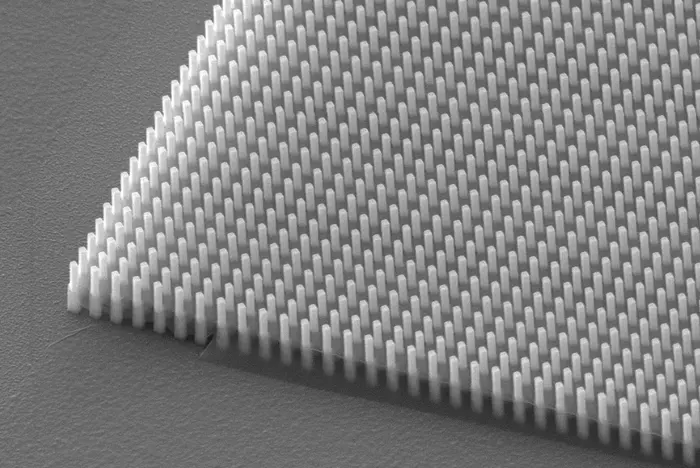The evolution of optical technology has reached an unprecedented milestone with the introduction of a revolutionary bilayer metasurface developed by researchers at Harvard University. This breakthrough not only enhances the capabilities of metasurfaces—ultra-thin, flat devices engineered to manipulate light—but also propels the field of optics into new realms of possibility. As these innovations gain traction, they hold the potential to redefine how we approach a wide range of applications, from imaging to augmented reality, fundamentally changing our interactions with light.
At its core, this discovery builds upon years of research into metasurfaces, which emerged as a pivotal solution to the limitations imposed by traditional optical systems that rely on bulky lenses. These lightweight devices, characterized by their nanoscale structures, have proven invaluable in a plethora of applications, allowing for precise control over light behavior at wavelengths previously deemed unattainable. The transition from conventional optics to metasurfaces marks a significant turning point in optical engineering and design, offering potential solutions for advancements in communications and imaging technologies.
The recent innovation—the bilayer metasurface—is notable for featuring two distinct layers of titanium dioxide nanostructures, effectively doubling the design’s capabilities. Under microscopic examination, the new structure resembles a cityscape of miniature skyscrapers, reflecting the intricate engineering that underpins its functionality. More than just an aesthetic improvement, this layering enables enhanced control over light’s properties such as wavelength, phase, and polarization, pushing the boundaries of what is possible with light manipulation.
Federico Capasso, the senior author of the study, articulates the importance of this development, stating that it represents a pinnacle achievement in nanotechnology. The bilayer design signifies a shift towards more sophisticated optical solutions, allowing researchers to explore dual functionalities within a single device. For example, these meta-optical systems could theoretically project one vivid image from one side and entirely different information from the opposite, showcasing a transformative approach to how visual data is conveyed through optical means.
The evolution from single-layer to bilayer metasurfaces addresses inherent constraints found in earlier models, particularly in how they handle light polarization. Historically, single-layer metasurfaces necessitated specific conditions to manipulate light’s polarization effectively. The flexibility introduced by the bilayer design paves the way for more complex optical devices without the need for intricate setups, making them vastly more practical for a range of applications.
Creating the bilayer metasurface demanded an unprecedented level of precision and innovation in fabrication techniques. Researchers utilized the facilities at Harvard’s Center for Nanoscale Systems to pioneer a fabrication process for robust, freestanding structures that maintain chemical independence between the two layers. This multi-level fabrication approach is a significant technical achievement, bridging the gap between advanced nanostructures and their practical optical applications.
The significance of this advancement is further underscored by its potential applications. With their newfound capabilities, these bilayer metasurfaces may facilitate the development of devices that integrate various functionalities into one compact unit, thus streamlining several aspects of optical engineering. The potential to create multifunctional optical devices signifies a monumental step towards sophisticated design in the field of optics, promoting innovation in commercial applications such as smartphone cameras, virtual reality headsets, and more.
Capasso and his team validated their groundbreaking design by demonstrating its functionality in a controlled experiment that manipulated polarized light. This proof-of-concept not only showcases the efficacy of their bilayer system but also hints at a future where additional layers may further enhance control over light. The prospects of incorporating more layers into metasurface designs open the door to extreme broadband operations with both high efficiency and precision, enhancing the potential for even more intricate optical functionalities.
The research team employed various federal funding sources to support this ambitious endeavor, with backing from the Office of Naval Research and the Air Force Office of Scientific Research, among others. This collaborative support highlights the broader implications of their work, emphasizing its significance in both academic and applied contexts. Moreover, the deployment of their technology through partnerships, such as with Harvard’s Office of Technology Development and the establishment of Metalenz, signifies a trajectory aimed at expert spin-off ventures that aspire to commercialize breakthrough optical technologies.
In addition to the compelling scientific advancements, this work exemplifies how interdisciplinary collaboration drives progress in complex fields like nanotechnology. In their pursuit of innovation, the team relied on contributions from various experts to refine their fabrication methods, reiterating the importance of collaboration in today’s research landscape. Such teamwork fosters growth, ensuring that cutting-edge technologies can transition swiftly from research labs to real-world applications.
In conclusion, the introduction of the bilayer metasurface represents a pivotal moment in optical science, and it may herald a new era of technology that enhances our capability to understand and utilize light. From augmented reality to advanced imaging systems, the implications of this research are vast and varied. As further studies unfold and newer applications are envisioned, the ability to manipulate light at unprecedented levels promises to facilitate changes across myriad scientific fields. The advancements driven by this technology will surely stimulate curiosity and further investigation into the exciting world of optical engineering.
Subject of Research:
Article Title: Free-standing bilayer metasurfaces in the visible
News Publication Date: 1-Apr-2025
Web References: https://www.nature.com/articles/s41467-025-58205-7
References: https://seas.harvard.edu/news/2016/06/metalens-works-visible-spectrum-sees-smaller-wavelength-light
Image Credits: Credit: Capasso group / Harvard SEAS
Keywords
Metasurfaces, visible light, light sources, nanostructures, light polarization, fabrication, applied physics, engineering, materials engineering, materials processing, microstructures, optics, nonlinear optics, optical properties, quantum optics.




